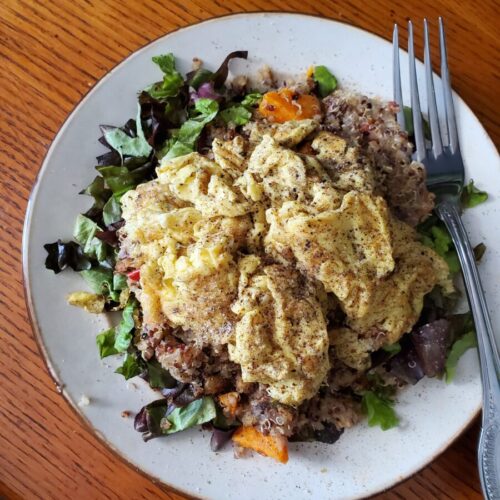
Scrambled Eggs
Scrambled eggs are so fundamental that we often don't really think about it. I can't even remember being taught how to scramble eggs. It took me probably 2 decades to think about what I was doing and why I was doing it. But there truly is an art on how to scramble eggs! And there are some very easy pitfalls to fall into that are easily avoided.
Equipment
- Skillet (preferably cast iron)
- Small Bowl
Ingredients
- 2-3 eggs per person
- 0-1 tsp. oil or butter of choice
- dash salt
- dash pepper
Instructions
- Preheat a skillet over medium-high heat.I use a cast iron pan to cook eggs and I have a new stove. So for me this is about a 6 on my stovetop. If you've already been using the pan or its preheated for longer than you anticipated, the cast iron may have heated more thoroughly and a 4 is likely adequate.If you're using a different type of pan, you're likely going to want a slightly lower temperature. Likewise, somewhere around a 4 is probably adequate.If your stove is older or heats at a different temperature, adjust accordingly. You want the pan to be hot enough to cook the eggs relatively quickly and I use a pretty high temperature here. But you're not deep frying the eggs! If sparks start frying, the heat is too high.
- If you like or need to, add oil at this point.If you're using a well-seasoned cast iron pan, you should only need a spritz of oil or the slightest amount of butter, if anything at all. The pan should naturally be non-stick and shouldn't require any grease. Although there is some personal preference here with flavor. Some people prefer it and I'll usually add a spritz of olive oil.For other types of pans, you may need upwards of a teaspoon of oil or butter to prevent sticking.I would always recommend using the least amount of oil or butter possible. Too much will make the eggs greasy. And again, we're not deep frying them! You want just enough oil or butter to keep the eggs from sticking.For most recipes I would recommend a high heat oil over olive oil or butter. Despite the fact that most of us have olive oil or butter lying around, they're not the best to cook with at higher temperatures because they burn easily. For eggs it doesn't matter that much, though. Since they cook so quickly, you can use whatever you prefer.
- Crack eggs into a bowl and whisk until fluffy.
- Add eggs to the skillet.
- Immediately move the eggs around gently with a spatula, making sure that they cook evenly.Stirring more constantly will result in runnier eggs.Stirring less vigorously will result in thicker eggs. Although, you may need to flip them to cook evenly. This will turn out more like a sheet of eggs than individually scrambled eggs. But you can get some nice browning when you do this without compromising the fluffiness of the egg.
- Continue to gently move the eggs around until barely cooked. This should take no more than a couple of minutes.
- Optionally add cheese about 60-90 seconds before the eggs are finished cooking.Just barely add the cheese when the egg is no longer runny, but hasn't quite solidified (see notes above on adding cheese).
- Remove eggs from the skillet when they begin to form and are no longer runny.Doneness is largely a personal preference. I prefer an egg that is just barely no longer runny. If you like a firmer or softer egg, though, adjust accordingly.
- Add salt, pepper, and any other seasoning of choice (see notes above on flavoring and seasoning).
- Serve immediately.Scrambled eggs are best served right off of the stove and don't reheat well. Reheating in the microwave or on the stove can overcook them and result in a rubbery consistency.